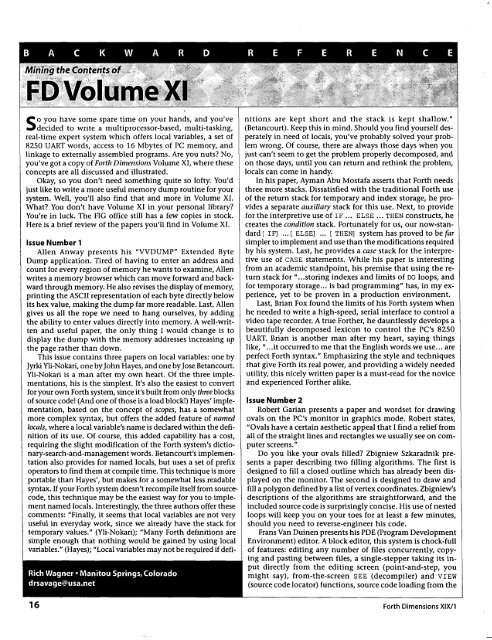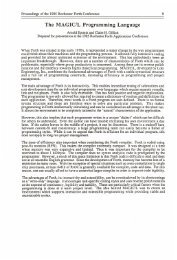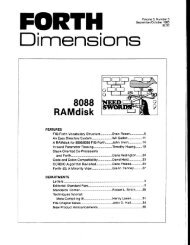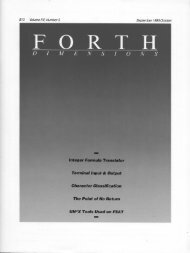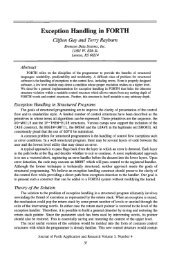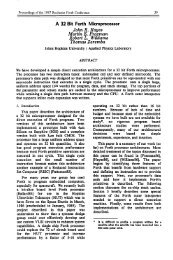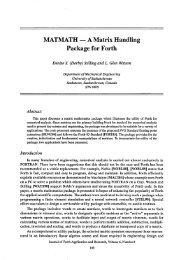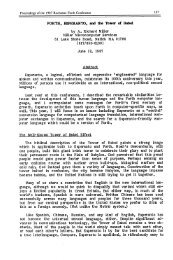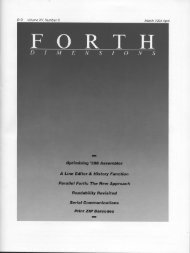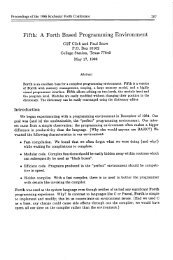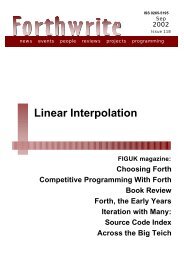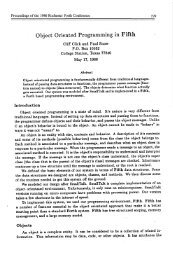1 - Forth Interest Group
1 - Forth Interest Group
1 - Forth Interest Group
You also want an ePaper? Increase the reach of your titles
YUMPU automatically turns print PDFs into web optimized ePapers that Google loves.
o you have some spare time on your hands, and you've<br />
S decided to write a multiprocessor-based, multi-tasking,<br />
real-time expert system which offers local variables, a set of<br />
8250 UART words, access to 16 Mbytes of PC memory, and<br />
linkage to externally assembled programs. Are you nuts No,<br />
you've got a copy of <strong>Forth</strong> Dimensions Volume XI, where these<br />
concepts are all discussed and illustrated.<br />
Okay, so you don't need something quite so lofty. You'd<br />
just like to write a more useful memory dump routine for your<br />
system. Well, you'll also find that and more in Volume XI.<br />
What You don't have Volume XI in your personal library<br />
You're in luck. The FIG office still has a few copies in stock.<br />
Here is a brief review of the papers you'll find in Volume XI.<br />
lssue Number 1<br />
Allen Anway presents his "VVDUMP" Extended Byte<br />
Dump application. Tired of having to enter an address and<br />
count for every region of memory he wants to examine, Allen<br />
writes a memory browser which can move forward and backward<br />
through memory. He also revises the display of memory,<br />
printing the ASCII representation of each byte directly below<br />
its hex value, making the dump far more readable. Last, Allen<br />
gives us all the rope we need to hang ourselves, by adding<br />
the ability to enter values directly into memory. A well-written<br />
and useful paper, the only thing I would change is to<br />
display the dump with the memory addresses increasing up<br />
the page rather than down.<br />
This issue contains three papers on local variables: one by<br />
Jyrki Yli-Nokari, one by John Hayes, and one by Jose Betancourt.<br />
Yli-Nokari is a man after my own heart. Of the three implementations,<br />
his is the simplest. It's also the easiest to convert<br />
for your own <strong>Forth</strong> system, since it's built from only three blocks<br />
of source code! (And one of those is a load block!) Hayes' implementation,<br />
based on the concept of scopes, has a somewhat<br />
more complex syntax, but offers the added feature of named<br />
locals, where a local variable's name is declared within the definition<br />
of its use. Of course, this added capability has a cost,<br />
requiring the slight modification of the <strong>Forth</strong> system's dictionary-search-and-management<br />
words. Betancourt's implementation<br />
also provides for named locals, but uses a set of prefix<br />
operators to find them at compile time. This technique is more<br />
portable than Hayes', but makes for a somewhat less readable<br />
syntax. If your ~orth system doesn't recompile itself from source<br />
code, this technique may be the easiest way for you to implement<br />
named locals. <strong>Interest</strong>ingly, the three authors offer these<br />
comments: "Finally, it seems that local variables are not very<br />
useful in everyday work, since we already have the stack for<br />
temporary values." (Yli-Nokari); "Many <strong>Forth</strong> definitions are<br />
simple enough that nothing would be gained by using local<br />
variables." (Hayes);"Local variables may not be required if defi-<br />
nitions are kept short and the stack is kept shallow."<br />
[Betancourt). Keep this in mind. Should you find yourself desperately<br />
in need of locals, you've probably solved your problem<br />
wrong. Of course, there are always those days when you<br />
just can't seem to get the problem properly decomposed, and<br />
Dn those days, until you can return and rethink the problem,<br />
locals can come in handy.<br />
In his paper, Ayman Abu Mostafa asserts that <strong>Forth</strong> needs<br />
three more stacks. Dissatisfied with the traditional <strong>Forth</strong> use<br />
of the return stack for temporary and index storage, he provides<br />
a separate auxiliary stack for this use. Next, to provide<br />
for the interpretive use of IF ... ELSE ... THEN constructs, he<br />
creates the condition stack. Fortunately for us, our now-standard<br />
[ IF] ... [ ELSE] ... [ THEN] system has proved to be far<br />
simpler to implement and use than the modifications required<br />
by his system. Last, he provides a case stack for the interpretive<br />
use of CASE statements. While his paper is interesting<br />
from an academic standpoint, his premise that using the return<br />
stack for "...storing indexes and limits of Do loops, and<br />
for temporary storage ... is bad programming" has, in my experience,<br />
yet to be proven in a production environment.<br />
Last, Brian Fox found the limits of his <strong>Forth</strong> system when<br />
he needed to write a high-speed, serial interface to control a<br />
video tape recorder. A true <strong>Forth</strong>er, he dauntlessly develops a<br />
beautifully decomposed lexicon to control the PC's 8250<br />
UART. Brian is another man after my heart, saying things<br />
like, "...it occurred to me that the English words we use... are<br />
perfect <strong>Forth</strong> syntax." Emphasizing the style and techniques<br />
that give <strong>Forth</strong> its real power, and providing a widely needed<br />
utility, this nicely written paper is a must-read for the novice<br />
and experienced <strong>Forth</strong>er alike.<br />
lssue Number 2<br />
Robert Garian presents a paper and wordset for drawing<br />
ovals on the PC's monitor in graphics mode. Robert states,<br />
"Ovals have a certain aesthetic appeal that I find a relief from<br />
all of the straight lines and rectangles we usually see on computer<br />
screens."<br />
Do you like your ovals filled Zbigniew Szkaradnik presents<br />
a paper describing two filling algorithms. The first is<br />
designed to fill a closed outline which has already been displayed<br />
on the monitor. The second is designed to draw and<br />
fill a polygon defined by a list of vertex coordinates. Zbigniew's<br />
descriptions of the algorithms are straightforward, and the<br />
included source code is surprisingly concise. His use of nested<br />
loops will keep you on your toes for at least a few minutes,<br />
should you need to reverse-engineer his code.<br />
Frans Van Duinen presents his PDE (Program Development<br />
Environment) editor. A block editor, this system is chock-full<br />
of features: editing any number of files concurrently, copying<br />
and pasting between files, a single-stepper taking its input<br />
directly from the editing screen (point-and-step, you<br />
might say), from-the-screen SEE (decompiler) and VIEW<br />
(source code locator) functions, source code loading from the<br />
<strong>Forth</strong> Dimensions XIXI1


